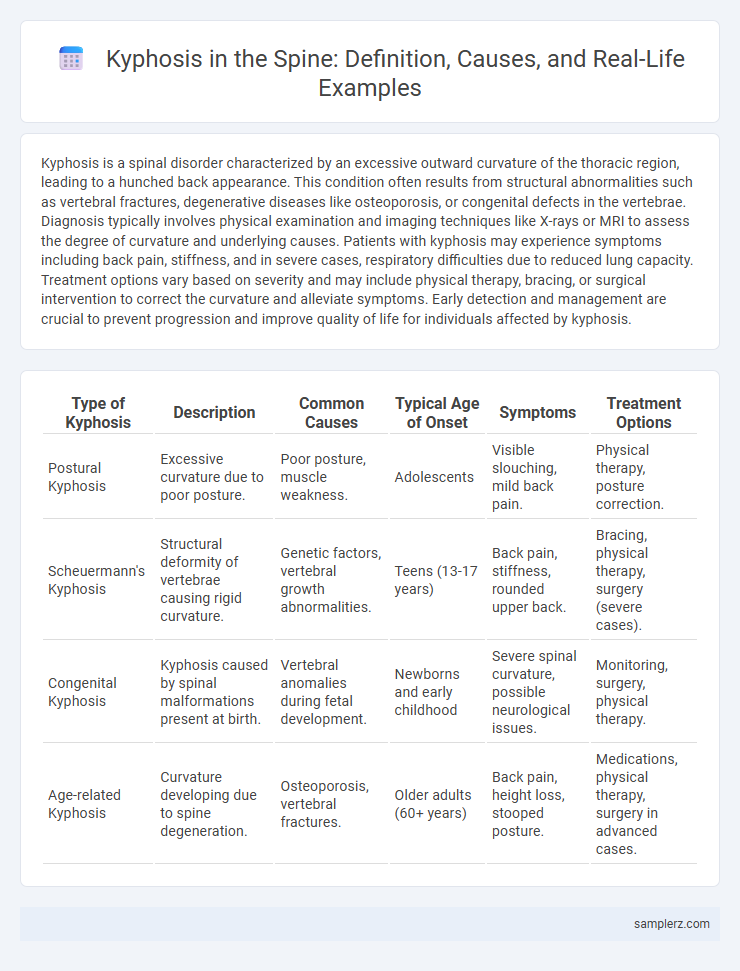Kyphosis is a spinal disorder characterized by an excessive outward curvature of the thoracic region, leading to a hunched back appearance. This condition often results from structural abnormalities such as vertebral fractures, degenerative diseases like osteoporosis, or congenital defects in the vertebrae. Diagnosis typically involves physical examination and imaging techniques like X-rays or MRI to assess the degree of curvature and underlying causes. Patients with kyphosis may experience symptoms including back pain, stiffness, and in severe cases, respiratory difficulties due to reduced lung capacity. Treatment options vary based on severity and may include physical therapy, bracing, or surgical intervention to correct the curvature and alleviate symptoms. Early detection and management are crucial to prevent progression and improve quality of life for individuals affected by kyphosis.
Table of Comparison
| Type of Kyphosis | Description | Common Causes | Typical Age of Onset | Symptoms | Treatment Options |
|---|---|---|---|---|---|
| Postural Kyphosis | Excessive curvature due to poor posture. | Poor posture, muscle weakness. | Adolescents | Visible slouching, mild back pain. | Physical therapy, posture correction. |
| Scheuermann's Kyphosis | Structural deformity of vertebrae causing rigid curvature. | Genetic factors, vertebral growth abnormalities. | Teens (13-17 years) | Back pain, stiffness, rounded upper back. | Bracing, physical therapy, surgery (severe cases). |
| Congenital Kyphosis | Kyphosis caused by spinal malformations present at birth. | Vertebral anomalies during fetal development. | Newborns and early childhood | Severe spinal curvature, possible neurological issues. | Monitoring, surgery, physical therapy. |
| Age-related Kyphosis | Curvature developing due to spine degeneration. | Osteoporosis, vertebral fractures. | Older adults (60+ years) | Back pain, height loss, stooped posture. | Medications, physical therapy, surgery in advanced cases. |
Understanding Kyphosis: Definition and Overview
Kyphosis is a spinal disorder characterized by an excessive outward curvature of the thoracic vertebrae, leading to a pronounced humpback appearance. Common examples include postural kyphosis, often found in adolescents due to poor posture, and Scheuermann's disease, a structural deformity of the vertebrae seen in adolescents. Accurate diagnosis involves clinical evaluation and radiographic imaging to assess the degree of curvature and guide appropriate treatment strategies.
Common Causes of Kyphosis in the Spine
Common causes of kyphosis in the spine include degenerative diseases such as arthritis, which lead to the deterioration of spinal discs and vertebrae. Osteoporosis is a major factor contributing to compression fractures, resulting in a pronounced forward curvature. Poor posture during adolescence and congenital spinal deformities also contribute significantly to the development of kyphosis.
Structural vs. Postural Kyphosis: Key Differences
Structural kyphosis involves permanent spinal deformities caused by vertebral fractures, congenital anomalies, or diseases like Scheuermann's disease, resulting in a fixed, often severe thoracic curvature. Postural kyphosis is characterized by a flexible spine that straightens when the individual corrects their posture, most commonly seen in adolescents due to muscle weakness or poor posture habits. Understanding these distinctions is crucial for accurate diagnosis and treatment planning, with structural kyphosis often requiring medical intervention while postural kyphosis benefits from physical therapy and posture correction.
Scheuermann’s Disease: A Typical Example of Kyphosis
Scheuermann's Disease is a common cause of structural kyphosis characterized by wedge-shaped vertebrae primarily affecting adolescents. This condition leads to an abnormal curvature of the thoracic spine, often resulting in a hunched posture and back pain. Early diagnosis and physical therapy are crucial for managing symptoms and preventing progression of the spinal deformity.
Osteoporosis-Related Kyphosis: Spinal Fractures Explained
Osteoporosis-related kyphosis often results from compression fractures in the thoracic spine, where weakened vertebrae collapse and cause abnormal forward curvature. These spinal fractures reduce bone density, leading to persistent back pain, impaired mobility, and increased risk of further deformities. Early diagnosis through bone density scans and timely treatment with bisphosphonates or calcium supplements can help manage symptoms and prevent progression.
Congenital Kyphosis: Birth Defects Affecting the Spine
Congenital kyphosis is a spinal deformity present at birth, characterized by an abnormal forward curvature of the thoracic or lumbar spine due to malformations of the vertebrae during fetal development. This condition may result from vertebral segmentation failure or failure of vertebral formation, leading to structural instability and progressive spinal curvature. Early diagnosis and surgical intervention are critical to prevent neurological complications and ensure proper spinal alignment in affected infants.
Kyphosis in Adolescents: Growth-Related Changes
Kyphosis in adolescents often results from growth-related changes during puberty, with Scheuermann's disease being the most common structural cause characterized by vertebral wedging and irregular endplates. This condition typically leads to an exaggerated thoracic curve exceeding 45 degrees, which can be identified through spine X-rays. Early detection and treatment, including physical therapy and bracing, are crucial to prevent progression and long-term postural deformities.
Elderly Kyphosis: Age-Associated Spinal Deformities
Elderly kyphosis is characterized by excessive curvature of the thoracic spine, commonly resulting from degenerative changes such as osteoporosis and vertebral compression fractures. This condition leads to posture imbalances, chronic back pain, and reduced respiratory function, significantly impairing quality of life in older adults. Early diagnosis and targeted interventions like physical therapy and spinal bracing are essential to manage symptoms and prevent progression of age-associated spinal deformities.
Symptoms and Physical Signs of Spinal Kyphosis
Spinal kyphosis commonly presents with a prominent, rounded upper back that appears hunched or slouched, often accompanied by stiffness and localized back pain. Patients may exhibit reduced spinal flexibility and muscle fatigue, along with visible spinal deformity such as a pronounced thoracic curve. Neurological symptoms including numbness or weakness can arise in severe cases due to spinal cord compression, highlighting the importance of early detection and clinical examination.
Treating and Managing Kyphosis in Patients
Treating and managing kyphosis involves a combination of physical therapy, bracing, and in severe cases, surgical intervention such as spinal fusion. Physical therapy focuses on strengthening the back muscles and improving posture to alleviate pain and prevent progression. Early diagnosis and customized treatment plans are essential to enhance patient outcomes and maintain spinal alignment.

example of kyphosis in spine Infographic
 samplerz.com
samplerz.com